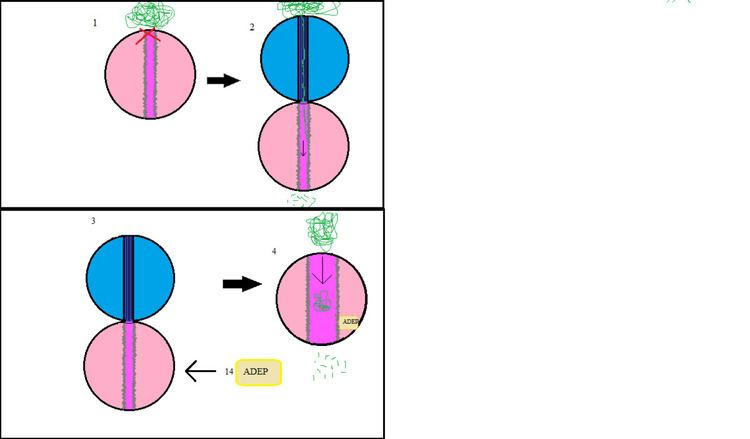 | ||
Acyl depsipeptides (ADEPs) are antibiotics that destroy intracellular proteins, by deregulating the ClpP protease.
Contents
Background
ADEPs are effective against gram positive bacteria, including pathogens. Upon binding, ADEPs prevent the assembly of the ClpP-ATPase complex. Clp-family proteins are ATP-dependent proteases which play a crucial role in the cell function by degrading misfolded proteins. ClpP is a monomer on its own but oligomerizes into tetradecamers when bound to ATPases. It needs an ATPase to identify, unfold, and transfer targeted big proteins into its proteolytic channel. In fact, ClpP on its own can only degrade peptides that are up to six amino acids long. ADEP binding induces ClpP proteolytic activation that leads to the proteins degradation in the cell, especially nascent proteins and the Ftsz protein which is an important protein in cell division. This potentially leads to cell death and is the reason why ADEP is a promising technique for drug development.
Chemistry and Mechanism
ADEPs are naturally occurring antibiotics. Certain bacteria produce them as defense mechanism in antagonist bacterial interactions. For instance, Streptomyces species produce them as secondary metabolites.
There are 6 forms of acyl depsipeptides that are distinguishable by their chemical structure and function. ADEPs generally differ by one or two functional groups that give some of them more flexibility, and stability. Their chemical structures are derived from ADEP 1 and are slightly different from one another. For instance, the only difference between ADEP 2 and ADEP 3 is the conformation of the difluorophenylalanine side chain. ADEP 2 has an S configuarion while ADEP 3 has an R configuarion.
ADEP antibiotics can be used to defeat resistant bacterial infections. They bind to ClpP and allow the protease to degrade proteins without the help of an ATPase. ADEP4/ClpP complexes target primarily newly formed proteins, and FtsZ which allows cell division. ClpP active form is a tetradecamer composed of two heptamers to which 14 ADEPs bind to.
ADEPs bind in the cavities formed by two ClpP monomers. Their binding site is composed of hydrophobic residues and corresponds to the binding sites of ClpP ATPases. Upon binding, a series of secondary structures shifts occur from the outer region to the center of ClpP. This puts the flexible N-terminal β-loop, into a disordered state. The β-loops normally form a gate above the proteolytic channel and prevent proteins to randomly go through. They are critical for ClpP interaction with its substrate and ATPases. When ADEP binds, the β-loops shift outward and this is accompanied by the shifts of two α-helices (α1 and α2), four β-strands (β1, β2, β3 and β5) and other loops which lead to the opening of the ClpP pore. In summary, ADEP4 deregulates ClpP function and change it from a closed state to an open one. At this point its specific proteolytic activity becomes a less controlled process, with the destruction of proteins that are around in the targeted cell.
Advantages
When bacteria and virus are exposed to antibiotics they create resistance or become tolerant to the antibiotic. In other words, bacteria/virus are adapting to this new conditions. ADEPs have a great potential for clinical application due to their high antibacterial activity against Gram-positive pathogens such as Staphylococcus aureus, and other pathogens that are found in biofilms and chronic infections. Their effectiveness increases when combined with different antibiotics such as ciprofloxacin, linezolid, vancomycin or rifampicin. Additional studies should focus more on the toxicity of ADEPs and their implementation for clinical use.
Applications
After the dysregulation of bacterial proteolytic machinery by a new class of antibiotics was published in the Journal Nature, many scientists started to study this antibiotic. Most of the experiments are focused on how the ADEPs/ClpP complex work, and the functional difference between ADEP and its synthetic congeners.
In 2011, P. Sass and co-workers performed a research focusing in the interaction and function of ADEPs and ClpP. They induced ADEP into Bacillus subtilis, Staphylococcus aureus and Streptococcus pneumoniae to identify how ADEP leads to the death of bacteria. The results demonstrated that ADEP is perturbing bacterial cell division. To identify the reason why ADEP inhibited cell division, researchers monitored septum formation and nucleoid segregation in ADEP B. subtilis and ADEP S. aureus. The S. aureus and B. subtilis samples gave equivalent results. This part showed the importance of wild type of ClpP and inhibition of septum formation is by direct interference of ADEP with the cell division components. Localization studies by GFP-labeled cell divisions proteins demonstrated that ADEP causes delocalization of Ftsz and inhibition of Z-Ring assembly in both species. The impact of ADEP in ∆clpX mutant indicated that ADEP is affecting cell division and that it also inhibits Z-ring assembly. Finally researchers repeat the experiment with ∆ClpP mutant to confirm that the presence of ADEP decreases abundance of FtsZ through ClpP degradation.
In 2013, scientists at Northeastern University performed an experiment focused on how ADEP 4/ClpP works. The experimental results showed the efficiency of ADEP4 when it is combined with other antibiotics. Researchers monitored the amount of trypic peptides, and found out that ADEP4/ClpP induces peptide degradation in a biofilm system. By using Mueller-Hinton broth they demonstrated that ADEP 4 was more effective than other antibiotics such as rifampicin or vancomycunin. However, they observed the same trends where ADEP4 combined to rifampicin is more effective and actually eradicates all stationary phases. The in vitro results showed the efficiency of ADEP 4 in mices infected with 4 different strains S. aureus, the laboratory strain SA113, and clinical isolates USA300, UAMS-1 and strain 37.
